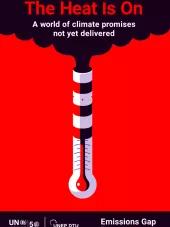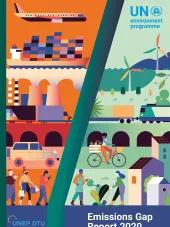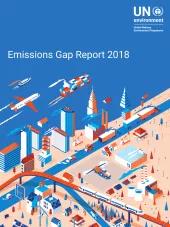The 2025 edition of the United Nations Environment Programme (UNEP) Emissions Gap Report, which tracks our progress in limiting global warming well below 2°C and pursuing 1.5°C in line with the Paris Agreement. Since 2010, it has provided an annual science-based assessment of the gap between estimated future global greenhouse gas (GHG) emissions if countries implement their climate mitigation pledges, and where they should be to avoid the worst impacts of climate change. NewClimate Institute has been contributing to the reports each year since 2014.
For this year's report, NewClimate Institute staff were part of the steering committee (Niklas Höhne), co-led Chapter 3 on the global landscape of NDCs and G20 progress (Takeshi Kuramochi) and contributed to Chapters 3 and 4 (Frederic Hans, Pablo Blasco Ladrero, Ana Missirliu and Jan-Luka Scheewel).
Press release (abridged version focusing on chapter with NewClimate contributions):
New climate pledges only slightly lower dangerous global warming projections
- Under a third of Parties to Paris Agreement submitted new NDCs by 30 September 2025
- Global temperatures now predicted to reach 2.3-2.5°C, down from 2.6-2.8°C last year
- Lack of ambition and action means exceedance of 1.5°C is approaching
Nairobi, 4 November 2025 – A UN Environment Programme (UNEP) assessment of available new climate pledges under the Paris Agreement finds that the predicted global temperature rise over the course of this century has only slightly fallen, leaving the world heading for a serious escalation of climate risks and damages.
UNEP’s Emissions Gap Report 2025: Off Target finds that global warming projections over this century, based on full implementation of Nationally Determined Contributions (NDCs), are now 2.3-2.5°C, compared to 2.6-2.8°C in last year’s report. Implementing only current policies would lead to up to 2.8°C of warming, compared to 3.1°C last year.
However, methodological updates account for 0.1°C of the improvement, and the upcoming withdrawal of the US from the Paris Agreement will cancel another 0.1°C, meaning that the new NDCs themselves have barely moved the needle. Nations remain far from meeting the Paris Agreement goal to limit warming to well-below 2°C, while pursuing efforts to stay below 1.5°C.
The report finds that the multi-decadal average of global temperature rise will exceed 1.5°C, at least temporarily. This will be difficult to reverse – requiring faster and bigger additional reductions in greenhouse gas emissions to minimize overshoot, reduce damages to lives and economies, and avoid over-reliance on uncertain carbon dioxide removal methods.
“Nations have had three attempts to deliver promises made under the Paris Agreement, and each time they have landed off target,” said Inger Andersen, Executive Director of UNEP. “While national climate plans have delivered some progress, it is nowhere near fast enough, which is why we still need unprecedented emissions cuts in an increasingly tight window, with an increasingly challenging geopolitical backdrop.”
“But it is still possible – just. Proven solutions already exist. From the rapid growth in cheap renewable energy to tackling methane emissions, we know what needs to be done. Now is the time for countries to go all in and invest in their future with ambitious climate action – action that delivers faster economic growth, better human health, more jobs, energy security and resilience.”
Off target
The report finds that only 60 Parties to the Paris Agreement, covering 63 per cent of greenhouse gas emissions, had submitted or announced new NDCs containing mitigation targets for 2035 by 30 September 2025. In addition to the lack of progress in pledges, a huge implementation gap remains, with countries not on track to meet their 2030 NDCs, let alone new 2035 targets.
Aligning with the Paris Agreement requires rapid and unprecedented cuts to greenhouse gas emissions above the pledges – a task made harder by emissions growing 2.3 per cent year-on-year to 57.7 gigatons of CO2 equivalent in 2024. Emissions in 2030 would have to fall 25 per cent from 2019 levels for 2°C pathways, and 40 per cent for 1.5°C pathways – with only five years left to achieve this goal.
Full implementation of all NDCs would reduce expected global emissions in 2035 by about 15 per cent compared with 2019 levels – although the US withdrawal will change these figures. These reductions are far below the 35 per cent and 55 per cent needed in 2035 to align with 2°C and 1.5°C pathways, respectively.
G20 action and leadership will be pivotal as G20 members – excluding the African Union – account for 77 per cent of global emissions. Seven G20 members have submitted new NDCs with targets for 2035, while three members have announced such targets. However, these pledges are not ambitious enough, G20 members are collectively not on track to achieve even their 2030 NDC targets, and G20 emissions rose by 0.7 per cent in 2024 – all pointing to the need for a massive ramp up in action by the biggest emitters.














